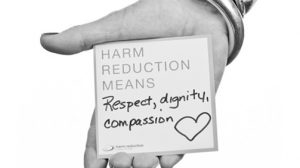Harm Reduction with Co-occurring Diagnosis
On a mild spring weekday in April, several Windhorse clinicians braved the unpredictable traffic of Boston to attend an all-day conference called “Attachment and Addiction: Harm Reduction and Relational Approaches,” that was co-sponsored by Ellenhorn and Psych Garden. This is a timely and resonant topic for Windhorse IMH, as we work from a “harm reduction” perspective grappling with the implications of honoring a view around substances and addictions of any sort, that is much more broad than the more mainstream view of an abstinence-only, “just say no” approach.
A Short History of Harm Reduction
The term “harm reduction” holds for some an outdated definition of needle exchange for substance abusers, which is a controversial and limited sense of a broad and increasingly important concept of support for people with addictions. This conference aimed at pointing out that “harm reduction” consists of many practical strategies and ideas centered on curtailing negative consequences associated with drug use. Harm Reduction can also be seen as a social justice movement that respects and believes in the rights of folks who abuse substances. From a Windhorse perspective, this may be seen as simply honoring the person “where they are,” as opposed to expecting an individual to be only where we want them to be and then trusting and cultivating authentic relationships that allow insight and health to emerge.
There are many elements of Harm Reduction philosophy that deeply resonate with Windhorse philosophy. Ross Ellenhorn in his opening to the Conference, brought up three names of harm reduction researchers I want to emphasize, Gabor Maté, Bruce Alexander, and Dr. Carl Hart. Maté, who wrote the remarkable book, “In the Realm of Hungry Ghosts: Close Encounters with Addiction,” which integrates detailed first-person accounts with strong scientific data, asks us to consider “Not why the addiction, but why the pain?” Maté points out that society has tended to treat only the symptoms of drug use, missing the underlying elements that are the root of the predicament. Alexander, a professor and author who wrote Globalization of Addiction, talks about how individuals in society have turned to drugs and other addictions because we feel disconnected from each other. And in another perspective that blends well with Windhorse work, neuropsychopharmacologist Dr. Hart studied social relations in the United States and said “The key issue is environment,” as he detailed the ways that our society creates stresses that cause dependency and drug use. Hart is known for studies that point out how crack was not what caused inner city problems, as commonly believed, but that it was conversely a system of oppression in society, that led to the crack problem. Hart notes that if we understand and work with the systems creating a need for drugs, we tend to have models of healing that offer more human dignity and thus end up being more effective.
Our society has commonly treated addiction to alcohol and substances with “tough love” and treatment models that often disempower the individual in trouble. In truth we are all prone to addictive behavior. Furthermore it makes sense that when one is in pain of any sort, we have a reasonable inclination to kill or escape from the pain or find any temporary relief and pleasure from the suffering. The stresses of living in society are at the root cause of addictive behavior. Studies show that support in the form of kindness and empathy work better than tough love in cultivating sustained recovery from addictions.
Harm Reduction: Abstinence vs. Biopsychosocial Model
 Thankfully, a bio-psycho-social model is recently being seen as an effective way of dealing with addictions and mental health. Windhorse has always manifested this approach to mental health recovery in general. This approach of dealing with addictions, taking into account the biological, behavioral, psychological, and environmental elements of health, consistent with Harm Reduction approach, makes sense and is backed by science. Compare this with an “abstinence-only” approach that has not been proven to be most effective. I need to point out that Harm Reduction includes an abstinence perspective, rather than being at odds with it. Abstinence, of course, is perfectly consistent with this model so long as the individual in recovery is choosing this behavior, as opposed to doing it because someone else (or a treatment program) tells them to.
Thankfully, a bio-psycho-social model is recently being seen as an effective way of dealing with addictions and mental health. Windhorse has always manifested this approach to mental health recovery in general. This approach of dealing with addictions, taking into account the biological, behavioral, psychological, and environmental elements of health, consistent with Harm Reduction approach, makes sense and is backed by science. Compare this with an “abstinence-only” approach that has not been proven to be most effective. I need to point out that Harm Reduction includes an abstinence perspective, rather than being at odds with it. Abstinence, of course, is perfectly consistent with this model so long as the individual in recovery is choosing this behavior, as opposed to doing it because someone else (or a treatment program) tells them to.
Dr. Mark Green, of Psych Garden, a dual diagnosis center in Belmont, MA, based in integrative treatment, explains how the attunement system works within the body through dopamine and endorphins working on a reward and error system, leaving us susceptible to anything that throws our homeostasis out of whack. Thus, a reason why abstinence often fails is that when opioids are taken, they can usurp the natural internal homeostasis system, creating tolerance within the body to this newer internal biological structure that was an adjustment to the opioid.. If we suddenly take away the drug, the person may be left with their internal system out of control in craving the opioid in order to return to homeostasis. This is why methadone, though a highly addictive drug in itself, has been an effective harm reducing step from heroin addiction. Although the action of methadone is similar to other human-made opioids, methadone works on parts of the brain and spinal cord to block the “high” effect of using heroin or other opiates. Methadone also helps reduce cravings and withdrawal symptoms caused by using these drugs. An individual is better off with methadone than heroin, and the individual may be more capable on methadone to be in a mental and physical state that enables them to take more steps in the direction of harm reduction and recovery. Steps like relational approaches to treatment and therapy are more accessible when a person is not completely lost in their dependency to an addictive drug.
Windhorse treatment, of course, places great emphasis on relationships as a foundation for healing. So, working with folks who are using substances must also include an interrelational dynamic with their Team and any addictions with which they are engaged.
Where Harm Reduction Theory and Windhorse Philosophy Meet
This brings up a topic of goal-setting that arose in dialogue amongst Windhorse clinicians who attended this conference, and seems to be a place where Harm Reduction theory and Windhorse philosophy meet. At Windhorse, we do not engage in typical “Treatment Plans” like programs that often begin their work with clients by establishing some written plan that sets the stage for treatment. The Windhorse approach is not adverse to intentions and planning. In our admissions process with prospective clients, for example, we are actively looking at any vision the individual has for themselves stepping into their future. We may also be interested in what others, including family and friends and other therapists and clinicians who know the individual, may be envisioning for their treatment or future. We may hold any or all of these intentions in varying degrees of importance.
An overall objective in the Windhorse approach is collaborating with an individual in discovering a more essential, life-affirming perspective resonant with that unique individual. The Team aims to maintain presence in their relationships, not be overly distracted by history or the future. Over time and through authentic relationships on the individual’s Team, meaningful and feasible goals organically emerge. This is not a magical process but a very real one that comes through a combination of supports and ways of perceiving a given individual’s experience. The relational element of recovery is part of the process, since it is through this dynamic process of genuine social relationships that trust-building, collaborative activity, and honest dialogue leads to understanding oneself and one’s social world better.
As we cultivate an environment where we treat others more in the manner of Maté’s empathic question “Not why the addiction but why the pain?”, we can be aware of ourselves in relationship with that question and to the individual with whom we are interacting, thus allowing a certain level of openness to ourselves engaged with someone who is experiencing their personal journey of recovery.
———-

